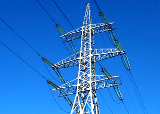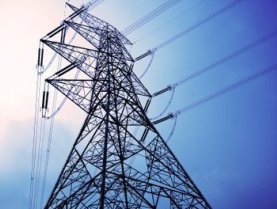The principle of operation of remote protection in 110 kV electrical networks
 Distance protection (DZ) in electrical networks of 110 kV voltage class performs the function of backup protection of high-voltage lines, preserves the phase-different line protection, which is used as the main protection in 110 kV electrical networks. DZ protects overhead lines from phase-phase short circuit. Consider the principle of operation and devices that perform the distance protection operation in 110 kV electrical networks.
Distance protection (DZ) in electrical networks of 110 kV voltage class performs the function of backup protection of high-voltage lines, preserves the phase-different line protection, which is used as the main protection in 110 kV electrical networks. DZ protects overhead lines from phase-phase short circuit. Consider the principle of operation and devices that perform the distance protection operation in 110 kV electrical networks.
The principle of operation of remote protection is based on the calculation of the distance, the distance to the point of failure. To calculate the distance to the fault location of a high-voltage power line, devices that perform the functions of distance protection, use the values of the load current and the voltage of the protected line. That is, circuits are used for the operation of this protection current transformers (CT) and voltage transformers (VT) 110 kV.
Remote protection devices are adapted to a specific power line, part of the power system, in such a way as to guarantee their step-by-step protection.
For example, the remote protection of one of the power lines has three stages of protection. The first stage covers almost the entire line, on the side of the substation where the protection is installed, the second stage covers the rest of the line to the adjacent substation and a small part of the electrical network extending from the adjacent substation, the third stage protects more distant sections. In this case, the second and third stages of remote protection preserve the protection located in an adjacent or more distant substation. For example, consider the following situation.
The 110 kV overhead line connects two adjacent substations A and B, and remote protection kits are installed at both substations. If there is a fault at the beginning of the line on the side of substation A, the protection set installed in that substation will operate, while the protection in substation B will maintain protection in substation A. In this case, for protection A, the damage will be within operation in the first stage, for protection B in the second stage.
Based on the fact that the higher the stage, the greater the protection response time, it follows that set A will work faster than protection set B. In this case, in the event of a failure of protection set A , after the time set for the operation of the second stage of protection, set B will be triggered ...
Depending on the length of the line and the configuration of the section of the power system, the required number of steps and the corresponding coverage area are selected for reliable protection of the line.
As mentioned above, each of the protection stages has its own response time. In this case, the further from the substation the fault is, the higher the protection response time setting. In this way, selectivity of protective operation in neighboring substations is ensured.
There is such a thing as defense acceleration. If the circuit breaker is triggered by remote protection, then, as a rule, one of its stages is accelerated (reaction time is reduced) in case of manual or automatic reclosing of the circuit breaker.
 Distance protection, according to the principle of operation, monitors the line resistance values in real time. That is, the determination of the distance to the fault location is done in an indirect way — each value of the line resistance corresponds to the value of the distance to the fault location.
Distance protection, according to the principle of operation, monitors the line resistance values in real time. That is, the determination of the distance to the fault location is done in an indirect way — each value of the line resistance corresponds to the value of the distance to the fault location.
Thus, in the event of a phase-to-phase short circuit of the power line, the DZ compares the resistance values recorded at a given moment by the measuring protection body with the specified resistance ranges (zones of action) for each of the stages.
If, for one reason or another, a voltage of 110 kV VT is not supplied to the DZ devices, then when a certain current value is reached, the load protection will operate falsely, turning off the power supply to the power line in the absence of faults. To prevent such situations, remote monitoring devices have a function to monitor the presence of voltage circuits, in the absence of which the protection is automatically blocked.
Also, distance protection is blocked in the event of a swing in the power supply.Swinging occurs when the synchronous operation of the generator is disturbed in a certain section of the power system. This phenomenon is accompanied by an increase in current and a decrease in voltage in the electrical network. For relay protection devices, including DZ, swings in the power supply are perceived as a short circuit. These phenomena differ in the rate of change of electrical quantities.
In the case of a short circuit, the change in current and voltage occurs immediately, and in the case of a swing, with a short delay. Based on this function, the remote protection has a blocking function that blocks the protection in the event of a swing in the power supply.
As the current increases and the voltage drops on the protected line, the blocking allows the operation of the remote control for a time sufficient for the operation of one of the protection stages. If the electrical values (mains current, voltage, line resistance) during this time have not reached the limits of the preset protection settings, the blocking body blocks the protection. That is, blocking the remote control allows the protection to work in the event of a real fault, but blocks the protection in the event of a swing in the power system.
What devices perform the function of remote protection in electrical networks
Until approximately the early 2000s, the functions of all relay protection and automation devices, including the distance protection function, were performed by electromechanical relay-based devices.
One of the most common devices built on electromechanical relays is EPZ-1636, ESHZ 1636, PZ 4M / 1, etc.
The above devices have been replaced by multi-function microprocessor protection terminals, which perform the function of several protections on the 110 kV line, including line distance protection.
Regarding distance protection specifically, the use of microprocessor devices for its implementation significantly increases the accuracy of its operation. Also a significant advantage is the availability of the microprocessor terminals of the protection of the function of determining the location of the fault (OMP) — showing the distance to the point of the line fault, which is fixed by the distance protection. The distance is indicated with an accuracy of tenths of a kilometer, which greatly facilitates the search for damage along the line by repair teams.
In the case of using old models of distance protection kits, the process of searching for a fault on the line becomes much more complicated, because with electromechanical type protections there is no possibility to fix the exact distance to the location of the fault.
Alternatively, in order to be able to determine the exact distance to the location of the fault, substations are installed trouble recorders (PARMA, RECON, Bresler, etc.), which record events in each individual section of the power grid.
If a fault occurs on one of the power lines, the emergency recorder will give information about the nature of the fault and its distance from the substation, indicating the exact distance.
